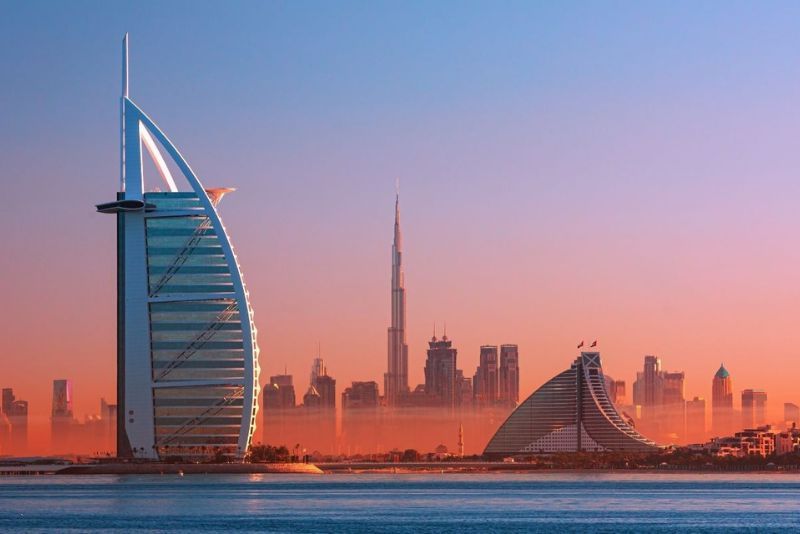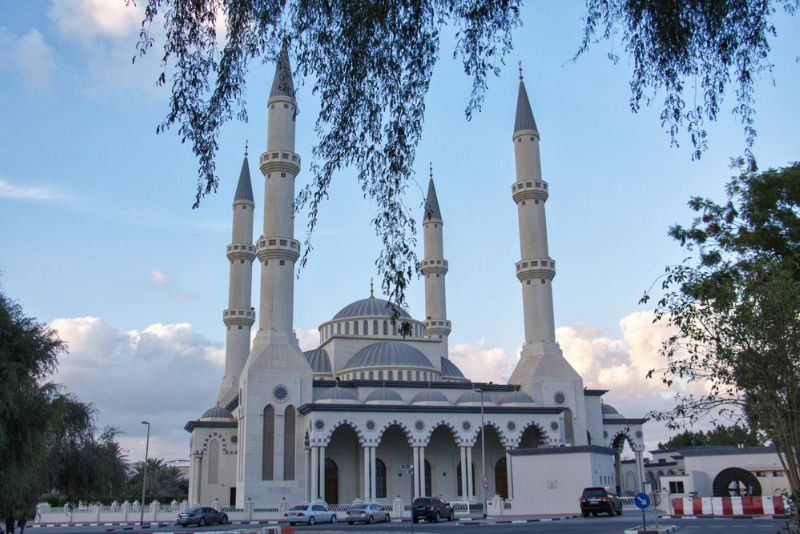Blue Mosque: Tickets and Tours
One of the best ways to discover what the bustling metropolis of Dubai has to offer, is with a ticket to the Blue Mosque — especially when combined with a visit to the city’s historical old town.
You’ll find the majestic Al Farooq Omar Bin Al Khattab Mosque — also known as Dubai’s Blue Mosque because it was modeled on Istanbul’s famous place of worship — surrounded by parks and embassies in a distinctly serene part of the city. It’s a relatively young building, only opened in 1986, and features inspiration from around the Islamic world, including Ottoman-like inscriptions and Andalusian architecture.
One of the best ways to discover what the bustling metropolis of Dubai has to offer, is with a ticket to the Blue Mosque — especially when combined with a visit to the city’s historical old town.
You’ll find the majestic Al Farooq Omar Bin Al Khattab Mosque — also known as Dubai’s Blue Mosque because it was modeled on Istanbul’s famous place of worship — surrounded by parks and embassies in a distinctly serene part of the city. It’s a relatively young building, only opened in 1986, and features inspiration from around the Islamic world, including Ottoman-like inscriptions and Andalusian architecture.

(0/24) checking Musement...
One of the best ways to discover what the bustling metropolis of Dubai has to offer, is with a ticket to the Blue Mosque — especially when combined with a visit to the city’s historical old town.
You’ll find the majestic Al Farooq Omar Bin Al Khattab Mosque — also known as Dubai’s Blue Mosque because it was modeled on Istanbul’s famous place of worship — surrounded by parks and embassies in a distinctly serene part of the city. It’s a relatively young building, only opened in 1986, and features inspiration from around the Islamic world, including Ottoman-like inscriptions and Andalusian architecture.
Visitors to this stunning mosque will be welcomed by its 21 domes and 4 minarets, towering an impressive 60 meters as they shimmer under the Arabian sun.

Here's everything you should to know about visiting the Blue Mosque, one of the most enchanting attractions in Dubai.
How much do Dubai’s Blue Mosque tickets cost?
There’s no entrance cost to visit Dubai’s Blue Mosque, but visitors should keep in mind that it is an active place of worship — and should consider checking local prayer times to minimize any disruption caused by the visit.
What are the best Blue Mosque tours?
Guided Blue Mosque and Dubai old town half-day tour
This 4-hour-long discovery of Dubai kicks off in style with an air-conditioned vehicle picking you up from your hotel. Your first stop takes you to the majestic sight of Dubai’s Blue Mosque, where you’ll enjoy a guided tour through the extensive grounds.
Your knowledgeable guide will tell you more about Islam while exploring the intricacies of the faith and how it’s manifested in the mosque’s design. Next, it’s off to the gateway to the historical city — Dubai Creek.
After enjoying a water taxi, you’ll explore the historical center of Dubai — visiting the famous Golden Souk and learning how commerce has always played an integral part in the city’s history.
Can I combine Blue Mosque tickets and tours with other attractions in Dubai?

Yes! Combining a visit to the Blue Mosque with one of Dubai’s many other attractions provides visitors with a holistic experience — while also saving them time and money on their exploration of this thriving city.
- Blue Mosque and Dubai boat tour: During this unforgettable outing, you’ll discover the city's best sights, capping off your visit with a relaxing boat cruise in Dubai. The tour is great for travelers on a time constraint, and you’ll visit many of Dubai’s major attractions.
- Burj Khalifa and Blue Mosque half-day tour: This half-day tour visits the Blue Mosque and the towering Burj Khalifa — exploring what these two vastly different buildings can tell us about Dubai and the Emiratis. After experiencing the peace and quiet that emanates from the Blue Mosque — you’ll head to the world’s tallest building for a once-in-a-lifetime view of this sprawling metropolis.
What will you see there?

Once inside Dubai’s Blue Mosque, you’ll explore the stunning interior, filled with majestic chandeliers and a library with over 40,000 religious books. Depending on the type of tour you choose, you may also visit Al Khayma Heritage House in Al Fahidi Historical District — to gain a more profound understanding of this mesmerizing city.
How to the Blue Mosque in Dubai?
Driving from the Dubai Frame, travel on the E11 Highway, in the direction of Palm Jumeirah. Exit on 35th Street and you’ll see the mosque on your right-hand side.
What are the opening times?
The Blue Mosque is open for visitors from Sunday to Thursday, with tours taking place twice daily at 10 AM and 4:15 PM. Be mindful of local prayer times when visiting.
When is the best time to visit the Blue Mosque in Dubai?

The best time to visit the Blue Mosque in Dubai, also known as the Al Farooq Omar Bin Al Khattab Mosque, is during the cooler months from November to March. Non-Muslim visitors are generally welcome during non-prayer times, so mornings or early afternoons on weekdays are ideal.
Which other attractions can be visited in Dubai?
Travel tips
- Both men and women should wear modest clothing that covers the arms, legs, and shoulders. Women are often required to cover their heads as well.
- You may be required to remove your shoes before entering, so wear something easy to take off.
- Observe silence and refrain from eating, drinking, or smoking on the premises of the Blue Mosque.
- While photography may be permitted in some areas, always be respectful and check for any restrictions.

